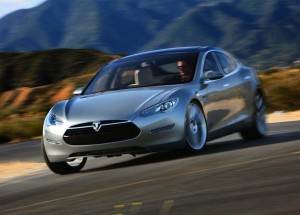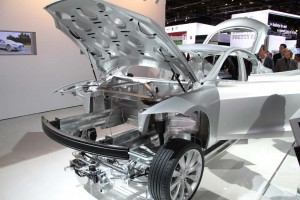A new video released by Silicon Valley start-up Tesla Motors suggests the maker is moving rapidly ahead with the development of its planned Model S sedan, and may very well make its ambitious target of going to market in 2012.
With a planned price tag under $50,000 – after federal and state rebates, where available – Tesla is hoping the Model S will prove naysayers wrong about the viability and flexibility of electric propulsion. Notably, to overcome so-called “range anxiety,” the ambitious automaker will offer three different battery packs: a base version delivering 160 miles under optimum conditions, one that pushes to 230 miles, and a third lithium-ion pack that will get as much as 300 miles per charge, about what a motorist might expect on a tank of gas with the typical automobile.
But company sources acknowledge that the larger batteries, especially the pack providing a 300-mile range, may be not only priced beyond what most motorists could afford – but that few, if any owners would be equipped to utilize its extended range without long layovers between drives.
Tesla has just released a video of one of the first early, or alpha, prototypes of the Model S undergoing road testing. (Click Here to see it in action.) As with the maker’s original Tesla Roadster, the new sedan is shockingly quiet, even at highway speeds, one of the advantages of using electric propulsion.
In a statement describing the behavior of the Model S, Tesla’s Chief Dynamicist, Graham Sutherland, suggested, “The first Alpha is amazingly agile for a car of its size. It has great handling balance and poised ride with communicative steering. Just goes to show what combining a low center of gravity with a very stiff body structure can achieve.”
At the Detroit Auto Show, Tesla is showing off the guts of the Model S, hoping to underscore just how solid that aluminum intensive chassis and body structure will be. A close look reveals a double wishbone suspension, and a rear subframe designed to hold both the rear suspension and motor, as well as the driveline’s electronic control system.
“We assiduously pursued weight savings at absolutely no expense of safety,” asserted Peter Rollinson, the project’s engineering team leader, during an auto show news briefing.
A key design strategy makes use of the battery pack – which contains about 7,000 laptop computer-sized batteries – as a structural element mounted underneath the cabin. This has a “multiplier effect,” according to Robinson, improving rigidity and reducing noise and vibration, he claims.
Tesla has been counting on the rapid development of lithium-ion batteries, founder Elon Musk recently stressed in a conversation with TheDetroitBureau.com. That will pay off in a variety of ways, he asserted: including both improved energy density – which, for a motorist, translates into longer range – and lower costs.
Where analysts were basing forecasts on a price of about $1,000 per kilowatt hour for lithium-ion in 2009, Musk broadly hinted Tesla is counting on that dipping to $400 or less per kWh during the life of the Model S program. The savings could be enormous.
Consider the Nissan Leaf, which uses 24 kWh of LIon batteries to get an average 100 miles per charge. A pack that size would drop from $24,000 to $9,600 if it underwent the same reduction in price Tesla anticipates. (Nissan insiders are even more optimistic – a well-placed source telling TheDetroitBureau.com that the Japanese maker expects to get its batteries down to $300 a kilowatt-hour – or lower.)
But the bigger, longer-range Model S will need a lot more battery. According to Rollinson, Tesla expects the sedan to consumer 300 watt-hours a mile. A quick bit of math and that works out to 48 kWh for the smallest Model S battery. And that doesn’t take into consideration that lithium technology doesn’t like to be complete drained or 100% charged up. So, more likely, the new electric vehicle will start with a base battery pack in the range of 52 to 55 kWh.
For the 230-mile model, that would jump to somewhere near 75 kWh. And for the 300-mile range Model S, the pack would be an enormous 100 kWh or larger – at least three times the size of the Leaf battery.
Even if Tesla were to price the car based on the anticipated plunge in lithium-ion pricing, the battery pack for a 300-mile Model S would cost the company about $20,000 more than for the base vehicle. If the traditional option model holds, the California maker would charge nearly as much as the base car for the upgrade.
For the record, Rollinson and other Tesla officials are not commenting, but sources confirm TheDetroitBureau.com’s math. And there are even more problematic numbers.
There are plenty of folks willing and able to spend the money for the extra range. But price might not be the biggest obstacle. To make use of all that range one needs to get the batteries charged up. And that won’t be easy.
As early battery car customers are quickly learning, using household 110-volt current to charge an electric vehicle is an undesirable option. With Leaf, you’ll plug in as soon as you get home for work and barely be ready to go in time for the morning commute.
Opting for a Level II 220-volt charger will typically trim the charge time down by at least half. Depending on the amperage of the charging system, that can bring charging times down significantly. Ford’s 7.5-amp Level II charger for the upcoming Focus Electric is expected to trim times down to just 3.5 hours, about half the time required to recharge Leaf using its lower-amperage system.
The larger Model S, with its huge 300-mile battery, would, at best require about 14 hours to get back on the road – at best. A lower-amperage charger would keep the sedan tethered for a day or more. That is, unless an owner were ready to head out on only a partial charge. But, at that point, what would justify paying the huge price premium for the extra kilowatt-hours?
There is an alternative, said Rollinson, when pressed with this analysis, Level III chargers, which use 440 volts converted to DC current. For vehicles like the Leaf and Focus Electric, such systems could yield an 80% quick “fill-up” in as little as 20 to 30 minutes. Even then, the 300-mile Model S might need a couple hours.
And, of course, that assumes an owner were near a Level III charger. Currently, there’s only one publicly available, near Portland, Oregon, and it’s anyone’s guess how quickly more will be added to the emerging electric vehicle infrastructure.
Significantly, this would move Model S owners away from the strategy of being able to recharge overnight – at home – when electric rates are lowest.
The ability to drive from Detroit to Chicago, New York to Boston, and nearly from L.A. to San Francisco without recharging does have its appeal. But whether potential buyers will look past the drawbacks remains to be seen.



Paul, you fail to understand that we charge our EV’s at a rate that’s appropriate for the range that we require in the time that we have available. Therefore, you will find Tesla owners today who charge from 13A to 70A, in as much as 20 hours, or as little as 3.5 hours. For me, this has little to do with the power that’s available from the wall (as I said I can run at 70A on my 100A supply) but everything to do with minimising the impact on the environment by controlling the time of the charge.
When the Model S arrives I will do the same thing… charge at a rate that meets my needs. I fully understand the power required from the wall and will install the equipment to support the charge rate I desire. As today, I have no doubt that my 70A supply will be rarely used because the car will be stationary for more time than is required to recharge it.
I also have no concerns that once I start traveling with the Model S in 2012-13 that Level 2 and DC Fast Charge will be available for me to use…. indeed, if Japan’s example is anything to go by we may quickly see DC Fast Charge replace Level 2 such that in 10 years time only DC is available on the road.
Fortunately, we only have to wait another year or so to discover who has the correct grasp of the Model S charging… the award wining Journalist or the Tesla owners/drivers… I know where I’d put my money…